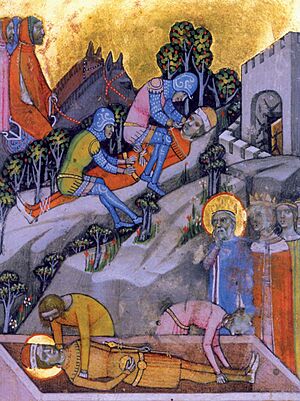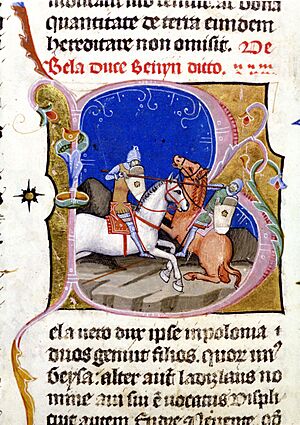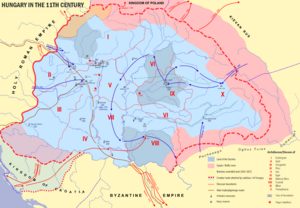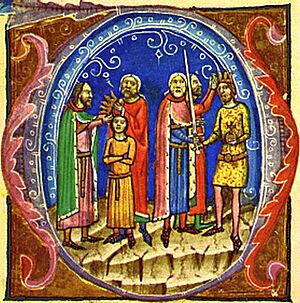Béla I of Hungary facts for kids
Quick facts for kids Béla I |
|
|---|---|

Béla I (Chronica Hungarorum)
|
|
| King of Hungary | |
| Reign | 6 December 1060 – 11 September 1063 |
| Coronation | 6 December 1060, Székesfehérvár |
| Predecessor | Andrew I |
| Successor | Solomon |
| Born | between 1015 and 1020 |
| Died | 11 September 1063 (aged 44–45) At the Kanizsva Creek, Kingdom of Hungary |
| Burial | Szekszárd Abbey |
| Spouse | Richeza or Adelaide of Poland |
| Issue |
|
| Dynasty | Árpád |
| Father | Vazul |
| Mother | Unknown woman from Tátony kindred |
| Religion | Roman Catholic |
Béla I (Hungarian: I. Bajnok or Bölény Béla, Slovak: Belo I.; c. 1015 – 11 September 1063) was the King of Hungary from 1060 until his death. He came from a powerful family called the Árpád dynasty. Béla's Christian name was Adalbert. He had to leave Hungary in 1031 with his brothers, Levente and Andrew. This happened after their father, Vazul, was punished. Béla found a new home in Poland. There, he married Richeza (also known as Adelaide), the daughter of the Polish king, Mieszko II Lambert.
Later, his brother Andrew became King of Hungary. Andrew invited Béla to come back home. Andrew gave Béla control over a large part of the kingdom, known as a "duchy." This area made up about one-third of Hungary. However, their relationship became difficult. King Andrew crowned his own son, Solomon, as king. He then made Béla publicly agree that Solomon should be the next ruler.
Béla, with help from his Polish family, rebelled against his brother. He took the throne in 1060. As king, he changed the money system and stopped the last uprising that wanted to bring back old pagan beliefs in Hungary. Sadly, Béla was badly hurt when his throne broke while he was sitting on it. He died soon after.
Contents
Life of Béla I
Early Life
Most old Hungarian stories say that Béla's father was Ladislas the Bald. Ladislas was a cousin of Stephen, Hungary's first king. However, some stories also mention that Béla and his two brothers, Levente and Andrew, were actually the sons of Ladislas the Bald's brother, Vazul. These stories also hint that the three brothers were born to "a girl from the Tátony clan." Today, historians believe that the three brothers were indeed Vazul's sons.
Béla was born between 1015 and 1020. Historians are not sure if he was the second or third son. His name "Béla" might come from a Turkish word meaning "noble." It could also be linked to the Slavic word for "white" or to the Biblical name Bela.
Years in Exile
King Stephen's only son, Emeric, died in 1031. After this, Vazul was the closest relative to become king. But King Stephen thought Vazul might follow old pagan beliefs. So, he chose his nephew, Peter Orseolo, instead. To make sure Peter would become king, Stephen had Vazul blinded. Because of this, Béla and his two brothers had to flee Hungary.
They first went to Bohemia, but life there was hard. So, they moved to Poland. The Polish king, Mieszko II, welcomed them warmly. Hungarian stories say that Béla joined a Polish fight against the pagan Pomeranians. He even defeated their leader in a one-on-one fight. The Illuminated Chronicle says the Polish king praised Béla's bravery. He gave Béla all the tribute from the Pomeranians. The king also gave his daughter, named either Richeza or Adelaide, to Béla in marriage. He also gave Béla a good amount of land. Béla was baptized and given the Christian name Adalbert before his marriage.
At that time the Pomeranians refused to pay their yearly tribute to the Duke of Poland, to whom they were subject. The Duke set out to exact by force of arms the tribute due to him from the Pomeranians. Then the Pomeranians, who were pagans, and the Poles, who were Christians, agreed together that their leaders should meet each other in a duel... Since [the] Duke [Mieszko] and his sons shrank in fear from the duel to be fought, [Béla] presented himself before them... "If it is pleasing to you, Poles, and to the lord Duke, although I am of nobler birth than that pagan, yet I will fight for the advantage of your kingdom and for the honour of the Duke." This was pleasing both to the Pomeranians and to the Poles. When they met in combat... [Béla] is said to have struck the Pomeranian so manfully that he unseated him from his horse... and [Béla] smote him with his sword. Then the Duke of the Pomeranians confessed himself at fault; and the Pomeranians... humbly submitted to the Duke of Poland and paid the accustomed tribute without murmuring.


King Mieszko II died in 1034. His son, Casimir, had to leave Poland. There was a time of disorder until Casimir returned around 1039. Béla stayed in Poland during this time. Some historians think he might have even helped manage the kingdom for his brother-in-law. Béla's brothers, Levente and Andrew, left Poland around 1038. They did not want to be seen as just "Béla's brothers" at the Polish court.
Becoming a Duke
After leaving Poland, Andrew and Levente went to Kiev. They returned to Hungary when a rebellion, led by pagans, broke out against King Peter Orseolo in 1046. King Peter was removed from power, and Andrew became king. Levente died that same year. Since Andrew had no children yet, he invited Béla to come back to Hungary.
Having lost one brother, King Andreas sent to Poland to his other brother Bela, calling him with great love and saying: "Once we shared poverty and labour together, and now I ask you, most beloved brother, that you come to me without tarrying, so that we may be companions in joy and share in the good things of the kingdom, rejoicing in each other's presence. For I have neither heir nor brother except you. You shall be my heir, and you shall succeed me in the kingdom." Won by these words, Béla came to the King with all his family. When the King saw him, he rejoiced with a great joy, because he was fortified by his brother's strength. Then the King and his brother Bela held a council and divided the kingdom into three parts, of which two remained under the proprietorship of the royal majesty or power and the third was put under the proprietorship of the Duke. This first division of the kingdom became the seed of discord and wars between the dukes and the kings of Hungary.
Béla returned in 1048. His brother gave him one-third of the kingdom and the title of duke. Béla's "duchy" included large areas along the eastern and northern borders. These areas included Nyitra (Nitra in Slovakia) and Bihar (in Romania). As duke, Béla had many powers, including making his own coins. The coins he minted had "BELA DUX" (Duke Béla) written on them.

The two brothers worked closely together for several years. They planned military strategies against the Germans, who often invaded Hungary in the early 1050s. Béla's nicknames, "the Champion" or "the Wisent," likely came from his bravery in these fights. The old stories say Andrew and Béla lived in "great peace." This was true even after Andrew had a son, Solomon, in 1053. Béla was present when his brother founded the Tihany Abbey, a Benedictine monastery, in 1055.
Their good relationship changed after King Andrew crowned his young son Solomon as king in 1057 or 1058. This crowning was part of peace talks with the Holy Roman Empire. The Germans would only agree to a marriage between Solomon and Judith, the sister of their young ruler, Henry IV, if Solomon's right to the throne was publicly confirmed. King Andrew then wanted to make sure his son would be the next king. He invited Béla to his home in Tiszavárkony. There, the King offered his brother a choice between a crown and a sword. These were symbols of royal and ducal power. However, Andrew had secretly ordered that Béla be killed if he chose the crown. Béla learned about this secret plan from one of his supporters. So, he chose the sword. After the meeting, he left for Poland.
Béla returned to Hungary in the autumn of 1060. He brought Polish soldiers given to him by Duke Boleslaus the Bold of Poland. Around the same time, German soldiers arrived to help Andrew. The civil war that followed ended with Béla's victory. He defeated his brother in two battles. King Andrew was badly hurt and died soon after. His supporters took his young son, Solomon, to Germany.
King of Hungary
Béla was crowned king in Székesfehérvár on 6 December 1060. He ordered that the families and belongings of those who had followed Solomon to Germany should be protected. This made many of Solomon's supporters return to Hungary and accept Béla as king. Béla changed the money system. He introduced "large coins of purest silver." To make the new money stable, he set maximum prices and stopped illegal trading. He also ordered that weekly markets should be held on Saturdays instead of Sundays.
Béla wanted to discuss his new ideas with the people. He sent messengers across Hungary to ask two wise elders from each village to come to a royal meeting. A large crowd of common people gathered in Székesfehérvár in 1061. They demanded that old pagan beliefs be brought back and that Christian leaders be harmed. But Béla quickly gathered his army and stopped their uprising within three days.
Béla tried to make peace with the Holy Roman Empire. He released all the German commanders who had helped his brother during the civil war. However, the young German ruler's advisors refused Béla's offers. In the summer of 1063, German leaders decided to launch a military attack on Hungary. Their goal was to put young Solomon back on the throne. Béla was planning to give up the throne to his nephew if Solomon would give him back his old duchy. But Béla was badly hurt when "his throne broke beneath him" at his home in Dömös. The king, who was "half-dead," was taken to the western border of his kingdom. He died at the Kanizsva Creek on 11 September 1063. Béla was buried in the Benedictine Szekszárd Abbey, which he had founded in 1061. After Béla's death, his three sons, Géza, Ladislaus, and Lampert, went to Poland for safety. Solomon then became king.
Family
Béla married a daughter of King Mieszko II Lambert of Poland around 1033. Her name was either Richesa or Adelheid. Their oldest children, Géza and Ladislaus, were born in Poland in the 1040s. Both later became kings of Hungary. Béla's third son, Lampert, was born after Béla returned to Hungary.
After Lampert, they had a daughter named Sophia. She first married Margrave Ulric I of Carniola, and later Duke Magnus of Saxony. Her younger sister, Euphemia, married Duke Otto I of Olomouc. Béla's third daughter, Helena, married King Demetrius Zvonimir of Croatia. An unnamed daughter of Béla became the first wife of a Hungarian nobleman, Lampert of the Clan Hont-Pázmány. Some historians also believe Béla had a fifth daughter, Lanka, who married Prince Rostislav Vladimirovich of Tmutarakan.
The family tree below shows Béla's ancestors, his children, and some relatives mentioned in this article.
| Taksony | a "Cuman" lady* | ||||||||||||||||||||||||||||||||||||||||||||||||||||||||||||
| Géza | Michael | a Bulgarian princess** | |||||||||||||||||||||||||||||||||||||||||||||||||||||||||||
| Stephen I of Hungary | a lady of the Tátony clan |
Vazul | Ladislas the Bald | ||||||||||||||||||||||||||||||||||||||||||||||||||||||||||
| Levente | Andrew I of Hungary | Anastasia of Kiev | Béla I | Richeza of Poland | |||||||||||||||||||||||||||||||||||||||||||||||||||||||||
| Solomon, King of Hungary | |||||||||||||||||||||||||||||||||||||||||||||||||||||||||||||
| (1) | |||||||||||||||||||||||||||||||||||||||||||||||||||||||||||||
| Géza I of Hungary | Ladislaus I of Hungary | Lampert | Magnus of Saxony | Sophia | Ulric I of Carniola | Euphemia | Otto I of Olomouc | ||||||||||||||||||||||||||||||||||||||||||||||||||||||
| Kings of Hungary (from 1095) |
|||||||||||||||||||||||||||||||||||||||||||||||||||||||||||||
| (1) | |||||||||||||||||||||||||||||||||||||||||||||||||||||||||||||
| Zvonimir of Croatia | Helena | daughter | Lampert of the Hont-Pázmány clan | Lanka*** | Rostislav of Tmutarakan | ||||||||||||||||||||||||||||||||||||||||||||||||||||||||
*A Khazar, Pecheneg or Volga Bulgarian lady.
Györffy writes that she may have been a member of the Bulgarian Cometopuli dynasty.
*Lanka is not mentioned as Béla I's daughter by all specialists.
Sources
Primary sources
- Simon of Kéza: The Deeds of the Hungarians (Edited and translated by László Veszprémy and Frank Schaer with a study by Jenő Szűcs) (1999). CEU Press. ISBN: 963-9116-31-9.
- The Hungarian Illuminated Chronicle: Chronica de Gestis Hungarorum (Edited by Dezső Dercsényi) (1970). Corvina, Taplinger Publishing. ISBN: 0-8008-4015-1.
Secondary sources
|
Béla I of Hungary
House of Árpád
Born: c. 1016 Died: 11 September 1063 |
||
| Regnal titles | ||
|---|---|---|
| Preceded by Andrew I |
King of Hungary 1060–1063 |
Succeeded by Solomon |



